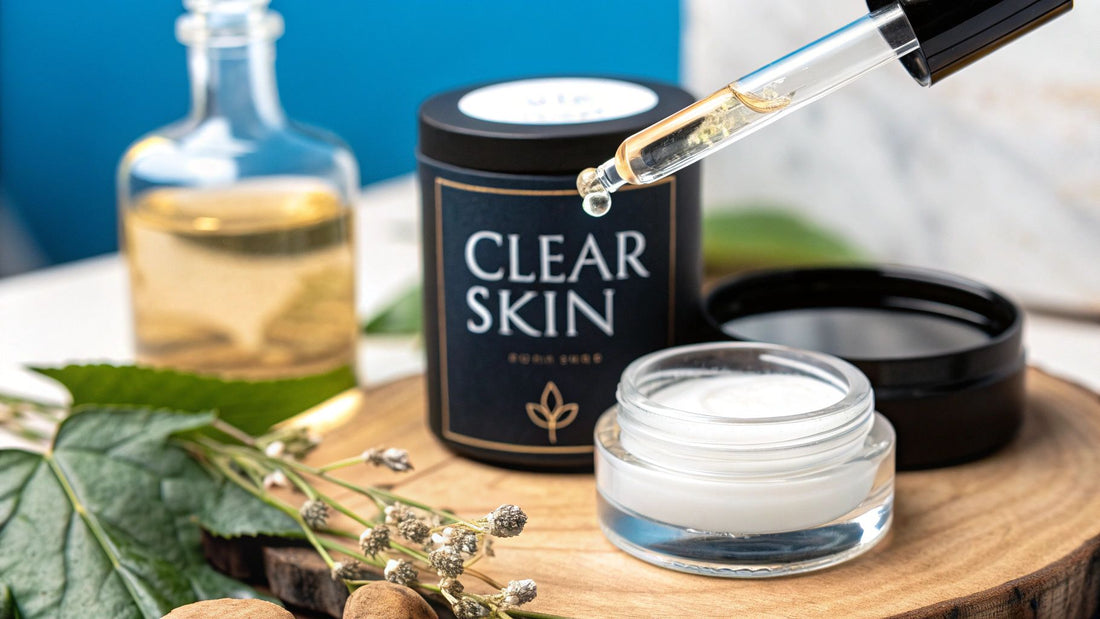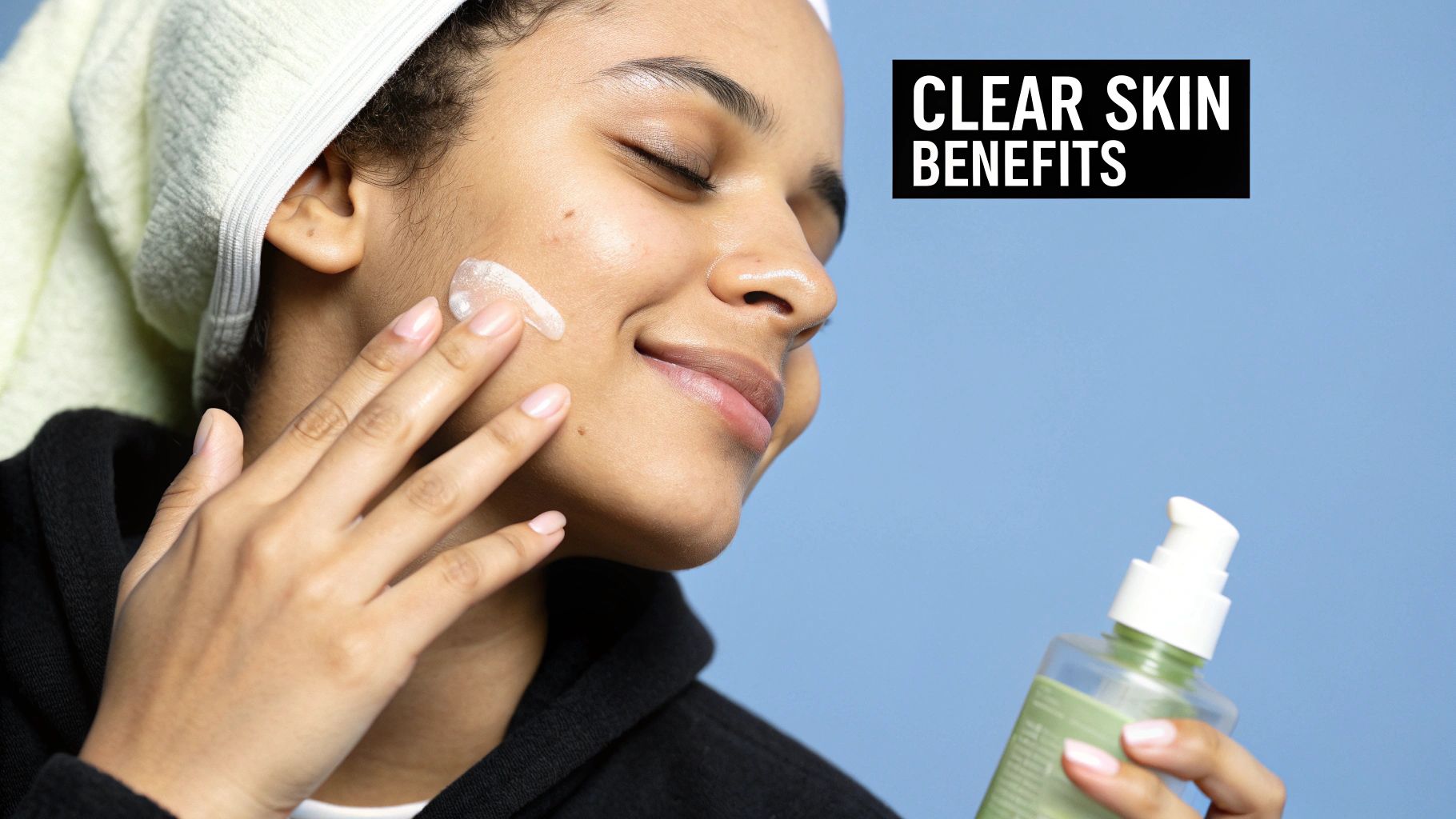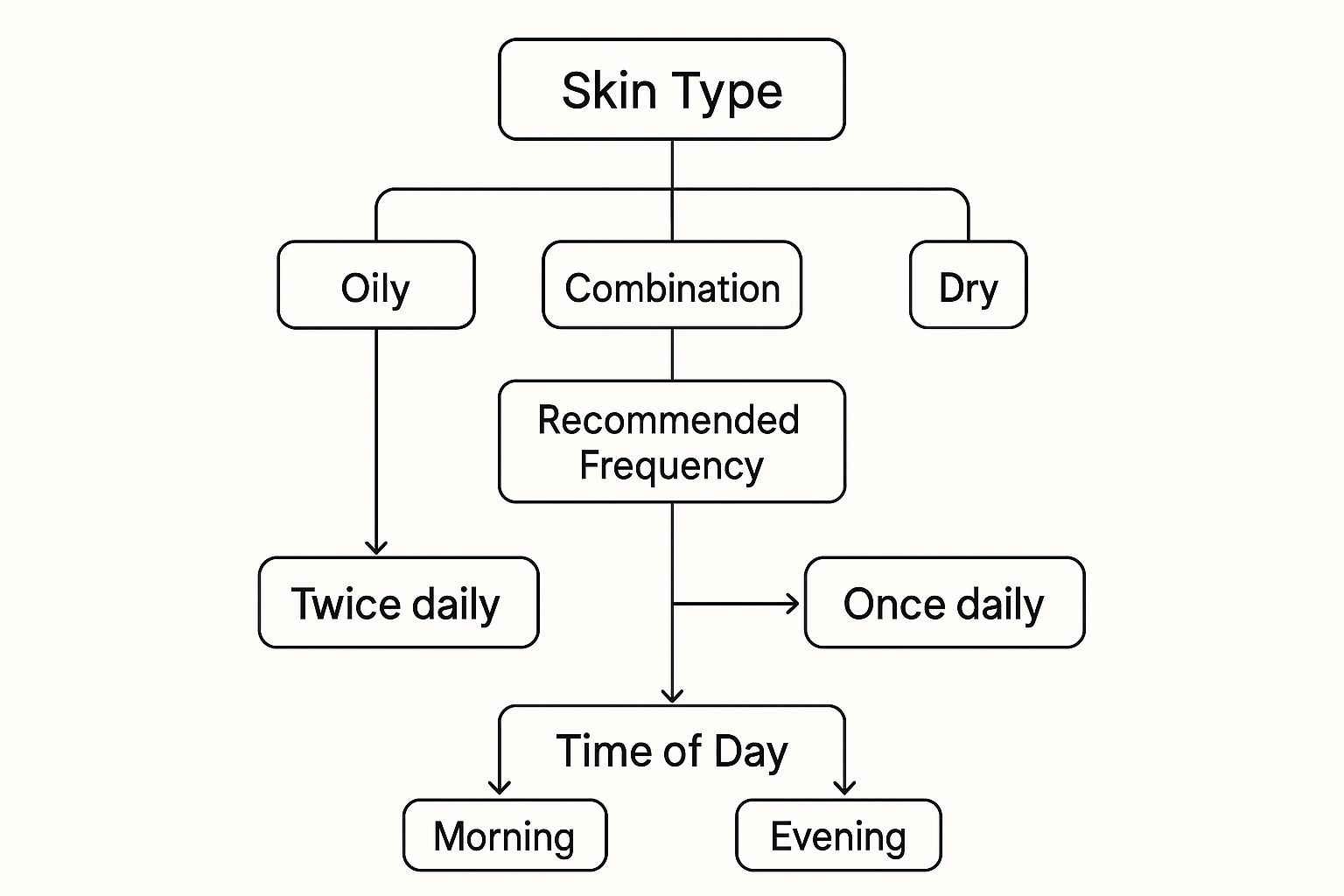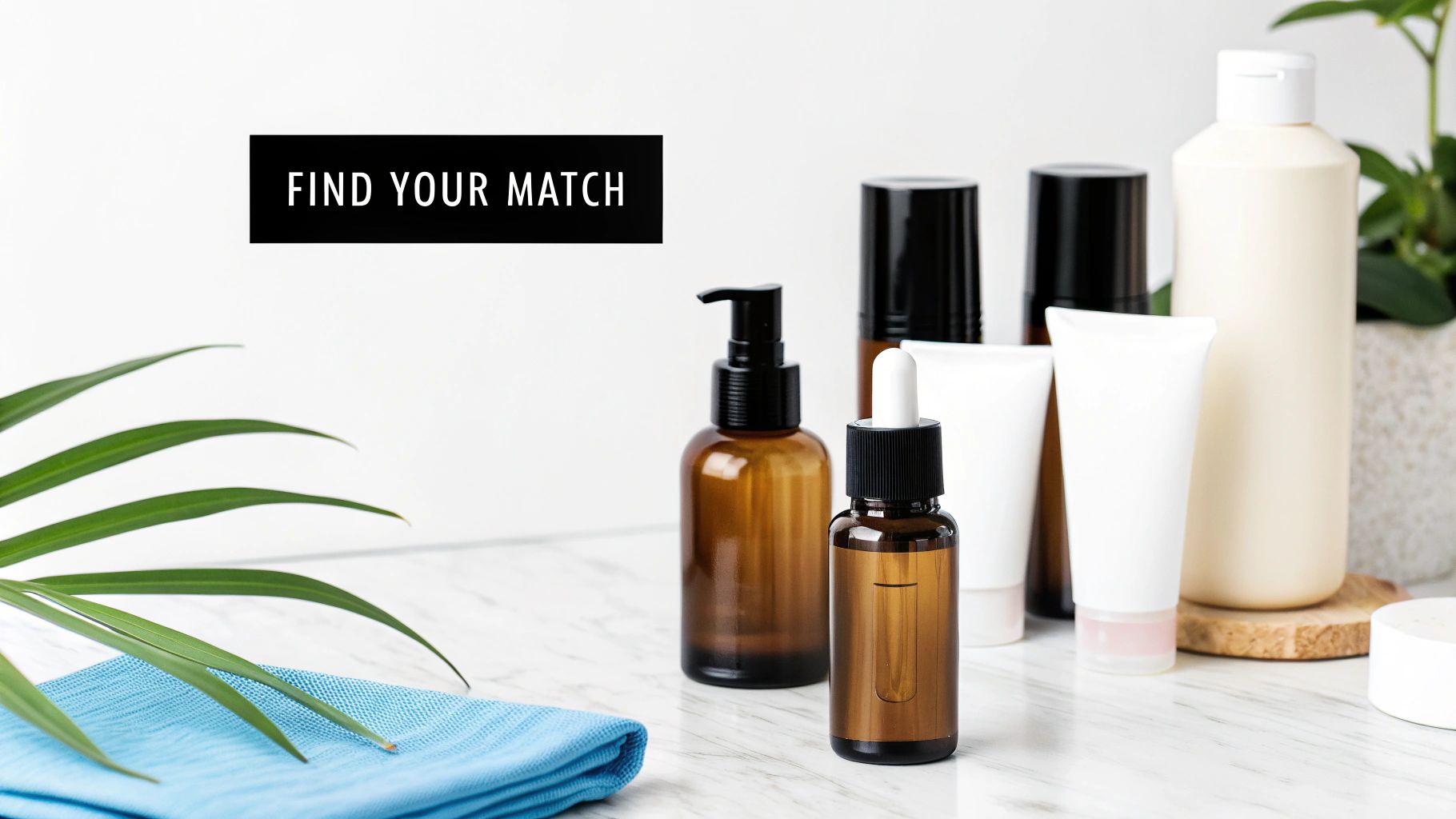
Moisturizer with Salicylic Acid for Clear Skin | A Complete Guide
Share
Fighting blemishes while keeping your skin hydrated can feel like an impossible balancing act. But what if one product could do both? That's the beauty of a moisturizer with salicylic acid. It brings together the deep-cleaning power of a top-tier active with the hydration your skin craves, all in one simple step. For anyone with oily or acne-prone skin, this kind of two-in-one skincare product is a game-changer for building a routine that actually works.
The Clear Skin Advantage of a Salicylic Acid Moisturizer
If you've ever dealt with breakouts, you probably know the frustrating cycle all too well. You attack a spot with a harsh treatment, which only dries out your skin. In response, your skin panics and produces even more oil, which leads to... you guessed it, more spots. A moisturizer with salicylic acid is designed to break that very cycle, offering a much smarter path to clear skin.
This isn't just about throwing two ingredients into a pot; it's about how they work together. The salicylic acid, a beta-hydroxy acid (BHA), is oil-soluble, meaning it can travel deep into your pores to break down the gunk—oil, dead skin cells, and debris—that causes blockages. While it's doing its job, the moisturizing ingredients in the formula are working to soothe, hydrate, and support your skin’s barrier.
Why This Combination Works
This clever combination is what makes these moisturizers so effective. Instead of stripping your skin and leaving it vulnerable, you get a gentle, continuous exfoliating effect while also keeping it hydrated and happy. This synergy is fantastic for a few reasons:
- Keeps breakouts at bay: By regularly clearing out your pores, you're stopping blackheads and pimples from even getting started.
- Calms down irritation: The hydrating elements help offset any potential dryness from the acid, so you can avoid that tight, flaky feeling.
- Strengthens your skin: A properly hydrated skin barrier is your first line of defence. It's stronger, heals faster, and is better able to protect itself.
It's no surprise that people are catching on. We're seeing a huge demand for skin care products backed by real science, and the market reflects that. The global salicylic acid market has already hit USD 472.9 million, and it’s still growing, with the UK's cosmetic industry playing a big part. With a forecasted growth rate of 6.3% CAGR, it’s clear that multi-tasking products like salicylic acid moisturizers are here to stay. You can find more details on this trend over at KBV Research.
Think of it as the ultimate peace treaty between exfoliation and hydration. You get all the clarifying benefits of an active ingredient without sacrificing the comfort and health of your skin barrier, setting the stage for long-term clarity.
How Salicylic Acid Transforms Your Skin

To really get why a moisturizer with salicylic acid is such a game-changer, we need to look at what makes this ingredient tick. It’s not just another exfoliant. While many acids only work on the very top layer of your skin, salicylic acid has a unique superpower: it’s oil-soluble.
Think of your pores as tiny, deep tunnels. These tunnels can easily get clogged with a stubborn mix of natural oils (sebum) and dead skin cells. Most water-based exfoliants can only really clean the entrance. But salicylic acid is different. Because it dissolves in oil, it can journey right through the sebum deep inside the pore, breaking up the blockage from the inside out. This is exactly how it gets to work on clearing blackheads and stopping new blemishes before they even start.
This deep-cleaning ability is revolutionary for anyone struggling with congested skin. It gets right to the root of the problem, dissolving the gunk that causes breakouts, rather than just dealing with the spots once they’ve appeared. You can learn more about its mechanism in our detailed guide on what is salicylic acid.
The Genius of a Moisturizing Formula
This is where putting salicylic acid into a moisturizer becomes such a clever move. Pairing this powerful acid with a hydrating base isn't just a nice-to-have; it's a strategic choice that makes the product both more effective and far more comfortable for your skin.
The moisturizing ingredients are more than just hydrators; they act as a sophisticated delivery system. They help to buffer the acid, which means it can get on with its job without overwhelming your skin. This simple but brilliant addition dramatically reduces the risk of dryness or irritation that some people experience when using exfoliating acids on their own.
Think of the moisturizer as a supportive partner. It helps the salicylic acid reach its target deep inside the pores while laying down a comforting blanket of hydration on the surface.
This dual-action approach means you get all the pore-clearing benefits without sacrificing your skin's protective barrier. The formula works hard to:
- Protect the skin barrier: Ingredients like ceramides and glycerin help keep your skin’s natural defences strong and intact.
- Prevent moisture loss: Hydrators such as hyaluronic acid lock in water, keeping your skin feeling plump and balanced.
- Soothe and calm: The moisturizing base helps to counteract any potential redness or sensitivity from the acid.
It’s no wonder this kind of balanced formulation is becoming so popular, especially as more of us in the UK look for skincare that’s backed by real science. The demand for targeted treatments like these is on the rise, with the global salicylic acid market projected to hit USD 880.4 million.
This powerful combination of deep exfoliation and supportive hydration is the secret to its success. Once you understand the science, it's easy to see how a moisturizer with salicylic acid can help you achieve clearer, healthier-looking skin.
Finding the Perfect Match for Your Skin Type
When you hear moisturizer with salicylic acid, your mind probably jumps straight to acne. While it's brilliant for breakouts, this ingredient's talents extend to a whole range of skin types. The real trick is understanding how it adapts to your skin's specific needs.
For anyone with oily skin, this kind of moisturizer is a game-changer. It feels like a constant battle to keep shine at bay and pores clear, right? This is where salicylic acid shines. It gets right into the pores to dissolve the gunk and excess oil that lead to blackheads, helping to mattify your complexion.
What's great is that it does all this heavy lifting while the moisturizing base provides the hydration your skin still needs. You end up with a balanced, comfortable finish—not that tight, stripped feeling.
A Solution for Combination Skin
Combination skin can be so frustrating. You're dealing with an oily T-zone but have dry, sometimes flaky, cheeks. It feels like you need two different routines. A salicylic acid moisturizer, however, is smart enough to handle both.
When you apply it all over, the salicylic acid hones in on the congested areas—your forehead, nose, and chin—to clear things out. At the same time, the formula's hydrating components give those drier patches the moisture they're craving. It’s a beautifully simple way to bring harmony to your face with just one product.
By targeting congestion where it starts while delivering balanced hydration, a moisturizer with salicylic acid helps create harmony across your entire face, simplifying your routine without compromising on results.
Surprising Benefits for Mature Skin
Now, this might sound a bit unexpected, but a salicylic acid moisturizer can be a brilliant addition for mature skin, too. As we get older, our skin's natural renewal cycle slows right down, which can leave our complexion looking a bit dull and feeling rough.
The gentle exfoliating effect of salicylic acid helps give that process a nudge. By clearing away the top layer of dead cells, it helps to reveal the brighter, smoother skin hiding underneath. This can even help soften the look of fine lines and create a more radiant tone. Pairing it with a complete skincare routine for acne-prone skin that also considers ageing can be a really effective strategy.
So, whether you're trying to control oil, balance combination skin, or simply want a smoother, more radiant complexion, a moisturizer with salicylic acid is a surprisingly versatile tool in your arsenal of skin care products.
How to Choose the Right Salicylic Acid Moisturizer
Walking down the skincare aisle can feel like a bit of a minefield, can't it? With so many skin care products promising the world, it’s hard to know where to start. When it comes to picking a moisturizer with salicylic acid, the secret is learning to read the label. It’s about finding a formula that truly works with your skin, not against it.
The best place to start is with the concentration of salicylic acid itself. You'll generally see products with anywhere from 0.5% to 2%. If you have sensitive skin or you’re just dipping your toes into the world of acids, a lower percentage like 0.5% is a fantastic starting point. It offers gentle exfoliation without a high risk of irritation.
On the other hand, a more robust 2% formula delivers a stronger punch, making it a better fit for those with very oily or congested skin who are already well-acquainted with active ingredients.
Finding Your Salicylic Acid Strength
This quick guide should help you pinpoint the right concentration for your skin's needs.
| Concentration | Best For | Key Considerations |
|---|---|---|
| 0.5% | Sensitive skin, beginners to chemical exfoliants, or daily maintenance | Gentle enough for daily use, but results will be more gradual. |
| 1% | Normal to combination skin, mild to moderate breakouts | A great middle-ground for consistent exfoliation without overwhelming the skin. |
| 2% | Oily, acne-prone, or congested skin; experienced acid users | The maximum strength available over-the-counter. Start slow and monitor for dryness. |
Remember, a higher percentage doesn't automatically mean better results—it's all about what your individual skin can handle.
Look for a Supportive Cast of Ingredients
But here's the thing: the percentage of salicylic acid is only one piece of the puzzle. The very best formulas pair this powerful BHA with a team of supportive ingredients that hydrate, soothe, and protect your skin barrier. Think of them as the backup singers who make sure the star of the show can shine without causing any drama.
Keep an eye out for these skincare heroes:
- Hyaluronic Acid: A true hydration powerhouse. It pulls moisture into the skin, giving you a plump, dewy look without a trace of oiliness.
- Niacinamide: This is salicylic acid's perfect partner. It's brilliant for calming redness, helping to get oil production under control, and minimising the look of large pores.
- Ceramides: These are the building blocks of a healthy skin barrier. They lock moisture in and keep irritants out, perfectly counteracting any potential dryness from the acid.
Choosing a product with this kind of well-rounded formula means you're not just fighting breakouts; you're nurturing your skin's long-term health. Understanding this balance is central to keeping your skin clear, a topic we dive into deeper in our guide on preventing acne breakouts.
This chart gives you a handy visual for tailoring usage to your specific skin type.

As you can see, someone with oily skin might find that using their moisturizer twice a day works wonders, whereas those with drier skin will likely get better results by starting with an evening application only.
A well-formulated moisturizer with salicylic acid is all about synergy. The acid clears the way, while ingredients like ceramides and hyaluronic acid follow behind to repair and hydrate. This creates a balanced environment where clear skin can truly thrive.
Ultimately, picking the right product comes down to feeling empowered. When you know how to read a label and understand what different ingredients do, you can confidently choose a moisturizer that will get the job done gently and effectively. It’s an approach that sets you up for success on your journey to a calmer, clearer complexion.
How to Slot Your New Moisturizer Into Your Routine

Alright, so you’ve got your new skincare product. The last thing you want to do is slap it on and hope for the best. Bringing any active ingredient into your skincare line-up takes a little bit of planning, especially if you want all the glowy benefits without any of the flaky, irritated downsides.
Even though a moisturizer with salicylic acid is often formulated to be gentle, it’s still a chemical exfoliant. The golden rule? Start slow.
Try using it just once a day to begin with, maybe in your evening routine after you’ve cleansed. This gives your skin plenty of time to get used to it. If everything feels calm and happy after a week or two, you could think about using it in the morning as well—especially if your skin is on the oilier side.
Building Your Morning and Evening Skincare
Figuring out where your new moisturizer fits in the order of things is half the battle. A good rule of thumb is to apply your skin care products from the thinnest consistency to the thickest.
A Simple Morning Routine:
- Gentle Cleanser: Always start with a fresh, clean face.
- Hydrating Toner or Serum (Optional): If you use any light, watery serums, they go on now.
- Moisturizer with Salicylic Acid: A pea-sized amount is all you need for your face and neck.
- Sunscreen: This step is absolutely non-negotiable. Acids make your skin more vulnerable to the sun, so you need to protect it.
A Simple Evening Routine:
- Cleanser: Wash off all the makeup, SPF, and general grime from the day.
- Toner or Serum (Optional): This is a great spot for other treatment serums you might be using.
- Moisturizer with Salicylic Acid: Lock everything in with your final hydrating layer.
If you take away only one piece of advice, let it be this: daily sunscreen is your best friend when using any exfoliating acid. A broad-spectrum SPF 30 or higher is essential for protecting your newly revealed skin cells from sun damage.
What Not to Mix with Salicylic Acid
To keep your skin barrier happy and intact, you need to be careful not to pile on too many powerful ingredients at the same time. It’s a classic skincare mistake that can lead to redness, sensitivity, and, ironically, even more breakouts.
Think of it like this: your active ingredients are specialised tools. You wouldn't use a sander and a power washer on the same piece of wood at the exact same time. You need to give each tool the space to do its job properly.
As a general rule, avoid using your salicylic acid moisturizer in the same routine as these ingredients:
- Retinoids (like Retinol or Tretinoin): Both are serious exfoliants. Using them together is a fast track to irritation and peeling.
- Other AHAs and BHAs (like Glycolic or Lactic Acid): Doubling down on different acids is a recipe for over-exfoliation.
- High-Potency Vitamin C Serums: This combination can sometimes be too much for the skin, causing sensitivity.
The smart way to use them all is to alternate. For example, use your salicylic acid moisturizer in the morning and save your retinol for the evening. This strategy lets you get the brilliant benefits of both ingredients without asking your skin to cope with an all-out assault.
Common Mistakes and How to Avoid Them

When you’re adding a moisturizer with salicylic acid to your routine, understanding what not to do is just as important as getting the steps right. Even the most brilliant skincare product can go rogue if it's used incorrectly. Let’s walk through the most common slip-ups so you can steer clear of them.
One of the biggest traps people fall into is the 'more is better' mindset. In a rush to see clear skin, it's tempting to slather on your moisturizer multiple times a day or double up with other strong exfoliants. Trust me, this approach almost always backfires.
This leads to over-exfoliation, which essentially dismantles your skin's natural protective barrier. Think of this barrier like a sturdy brick wall; salicylic acid is meant to gently chip away at the old, loose bricks. Overdoing it is like taking a sledgehammer to the whole structure. The result? Redness, raw sensitivity, and sometimes, your skin panics and produces even more oil, making breakouts worse.
Being Impatient and Inconsistent
Another classic error is throwing in the towel too soon. Skincare is a long game, not a quick fix. Because salicylic acid gets to work deep down in the pores, it takes a little while for those benefits to show up on the surface.
You probably won't wake up with brand-new skin overnight, and that's okay. Consistency is what really matters here. It takes a good few weeks for your skin cells to turn over, so you'll want to stick with your new routine for at least 6-8 weeks to really see a difference in your skin's texture and clarity. If you bail after a fortnight, you'll never see what the product is truly capable of.
A damaged skin barrier can't defend itself properly, leading to a cycle of irritation and breakouts. The goal is to gently guide your skin towards clarity, not force it with an aggressive approach.
Finally, we come to what is arguably the most critical mistake of all: skipping sunscreen. Any exfoliating acid, salicylic acid included, makes your skin more vulnerable to sun damage. If you don't apply a broad-spectrum SPF every single morning, you're setting yourself up for sunburn, dark spots, and premature ageing – completely cancelling out all your good work. Make sunscreen a non-negotiable part of your daily ritual.
Common Questions About Salicylic Acid Moisturizers
Even when you've done your homework, starting a new product can bring up a few lingering questions. To clear things up and help you feel confident, I've answered some of the most common queries I hear about moisturizers with salicylic acid.
Can I Use a Moisturizer With Salicylic Acid Every Day?
For most people, yes, you absolutely can. These products are usually designed for daily use, often containing gentle concentrations of salicylic acid somewhere between 0.5% and 1%.
However, if you have particularly sensitive skin or you're just starting out with acids, it's always best to ease into it. Try applying it every other evening to begin with, which gives your skin a chance to get used to the new ingredient. The golden rule of skincare is simple: listen to your skin. If you spot any irritation or feel unusually dry, just dial it back a bit.
Will a Salicylic Acid Moisturizer Make My Skin Dry?
A well-made one shouldn't. The whole point of putting salicylic acid into a moisturizing formula is to get the best of both worlds—exfoliation without the dreaded dryness. These moisturizers are packed with hydrating ingredients like glycerin, hyaluronic acid, or ceramides to balance out the acid's effects.
If you do start to feel tight or see a bit of flakiness, it might just mean you're applying it a little too often for your skin's liking. It could also be a sign that you need a richer formula to give your skin barrier that extra bit of support.
Skincare is a marathon, not a sprint. Consistency is what delivers lasting change. Sticking with your routine is essential to let the ingredient work its magic deep within the pores.
How Long Until I See Results?
This is where a little patience really pays off. You might notice your skin feels less oily or looks a bit less red within the first couple of weeks, but the real changes take time to appear.
When it comes to seeing a real difference in your skin's texture and a significant drop in breakouts, you'll want to give it at least 6-8 weeks. The process of skin cell turnover doesn't happen overnight. Giving the salicylic acid enough time to do its job consistently is the secret to achieving that calm, clear complexion you're after.
Ready to achieve the clear, balanced skin you've been looking for? Explore the science-backed skincare solutions at P-Eleven and find the perfect skin care products to elevate your routine. Visit us today to start your journey.


